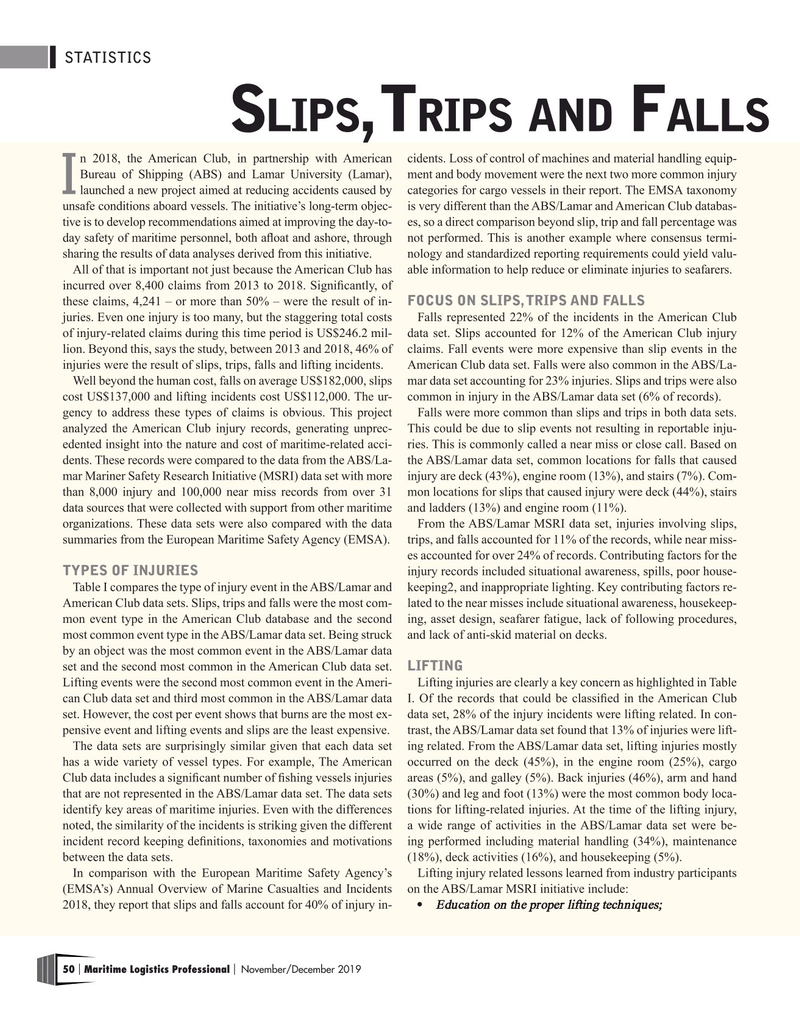
Page 50: of Maritime Logistics Professional Magazine (Nov/Dec 2019)
Short Sea Shipping Ports
Read this page in Pdf, Flash or Html5 edition of Nov/Dec 2019 Maritime Logistics Professional Magazine
STATISTICS
S , T FlipS ripS and allS n 2018, the American Club, in partnership with American cidents. Loss of control of machines and material handling equip-
Bureau of Shipping (ABS) and Lamar University (Lamar), ment and body movement were the next two more common injury
Ilaunched a new project aimed at reducing accidents caused by categories for cargo vessels in their report. The EMSA taxonomy unsafe conditions aboard vessels. The initiative’s long-term objec- is very different than the ABS/Lamar and American Club databas- tive is to develop recommendations aimed at improving the day-to- es, so a direct comparison beyond slip, trip and fall percentage was day safety of maritime personnel, both afoat and ashore, through not performed. This is another example where consensus termi- sharing the results of data analyses derived from this initiative. nology and standardized reporting requirements could yield valu-
All of that is important not just because the American Club has able information to help reduce or eliminate injuries to seafarers.
incurred over 8,400 claims from 2013 to 2018. Signifcantly, of
FOCUS ON SLIPS, TRIPS AND FALLS these claims, 4,241 – or more than 50% – were the result of in- juries. Even one injury is too many, but the staggering total costs Falls represented 22% of the incidents in the American Club of injury-related claims during this time period is US$246.2 mil- data set. Slips accounted for 12% of the American Club injury lion. Beyond this, says the study, between 2013 and 2018, 46% of claims. Fall events were more expensive than slip events in the injuries were the result of slips, trips, falls and lifting incidents. American Club data set. Falls were also common in the ABS/La-
Well beyond the human cost, falls on average US$182,000, slips mar data set accounting for 23% injuries. Slips and trips were also cost US$137,000 and lifting incidents cost US$112,000. The ur- common in injury in the ABS/Lamar data set (6% of records).
gency to address these types of claims is obvious. This project Falls were more common than slips and trips in both data sets. analyzed the American Club injury records, generating unprec- This could be due to slip events not resulting in reportable inju- edented insight into the nature and cost of maritime-related acci- ries. This is commonly called a near miss or close call. Based on dents. These records were compared to the data from the ABS/La- the ABS/Lamar data set, common locations for falls that caused mar Mariner Safety Research Initiative (MSRI) data set with more injury are deck (43%), engine room (13%), and stairs (7%). Com- than 8,000 injury and 100,000 near miss records from over 31 mon locations for slips that caused injury were deck (44%), stairs data sources that were collected with support from other maritime and ladders (13%) and engine room (11%).
organizations. These data sets were also compared with the data From the ABS/Lamar MSRI data set, injuries involving slips, summaries from the European Maritime Safety Agency (EMSA). trips, and falls accounted for 11% of the records, while near miss- es accounted for over 24% of records. Contributing factors for the
TYPES OF INJURIES injury records included situational awareness, spills, poor house-
Table I compares the type of injury event in the ABS/Lamar and keeping2, and inappropriate lighting. Key contributing factors re-
American Club data sets. Slips, trips and falls were the most com- lated to the near misses include situational awareness, housekeep- mon event type in the American Club database and the second ing, asset design, seafarer fatigue, lack of following procedures, most common event type in the ABS/Lamar data set. Being struck and lack of anti-skid material on decks.
by an object was the most common event in the ABS/Lamar data set and the second most common in the American Club data set. LIFTING
Lifting events were the second most common event in the Ameri- Lifting injuries are clearly a key concern as highlighted in Table can Club data set and third most common in the ABS/Lamar data I. Of the records that could be classifed in the American Club set. However, the cost per event shows that burns are the most ex- data set, 28% of the injury incidents were lifting related. In con- pensive event and lifting events and slips are the least expensive. trast, the ABS/Lamar data set found that 13% of injuries were lift-
The data sets are surprisingly similar given that each data set ing related. From the ABS/Lamar data set, lifting injuries mostly has a wide variety of vessel types. For example, The American occurred on the deck (45%), in the engine room (25%), cargo
Club data includes a signifcant number of fshing vessels injuries areas (5%), and galley (5%). Back injuries (46%), arm and hand that are not represented in the ABS/Lamar data set. The data sets (30%) and leg and foot (13%) were the most common body loca- identify key areas of maritime injuries. Even with the differences tions for lifting-related injuries. At the time of the lifting injury, noted, the similarity of the incidents is striking given the different a wide range of activities in the ABS/Lamar data set were be- incident record keeping defnitions, taxonomies and motivations ing performed including material handling (34%), maintenance between the data sets. (18%), deck activities (16%), and housekeeping (5%).
In comparison with the European Maritime Safety Agency’s Lifting injury related lessons learned from industry participants (EMSA’s) Annual Overview of Marine Casualties and Incidents on the ABS/Lamar MSRI initiative include: 2018, they report that slips and falls account for 40% of injury in- • Education on the proper lifting techniques; 50 Maritime Logistics Professional November/December 2019 | |

 49
49

 51
51
